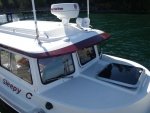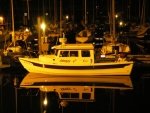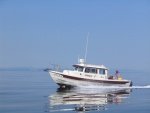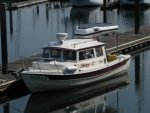colbysmith
Active member
I had first replied with this comment to another thread, but feel it should have it's own related thread:
Bob, regarding DSC. I don't know what the commercial requirements are, but I doubt most folks know how to use it, or even have it hooked up properly. This past summer I made several attempts to use my DSC to contact other vessels, both commercial freighters and small private yachts. None of which replied back. TO be honest, I don't even know if my radio's DSC is working properly as I have made numerous attempts in the Door County area to send the test code to the USCG, with no response. However, I also sent a test out in Port Washington, and got an immediate reply. (So I think my radio's DSC IS working. But to be sure, I have it at the manufacturer now to be checked out.) Finally, while I got no reply back to my test signal while at the Alton gathering (near St. Louis), I did try using DSC to contact a private yacht at the end of the dock. (In these contacts with other boats, it is in connection with their AIS signals that I'm registering, and then trying to initiate contact using the DSC function. After not getting any response, I actually walked down and spoke to the owners. Come to find out, their radio was alarming (in response to my DSC call), but they didn't know what it was. After some conversation, they offered to "work" with me again on the calls, but were unable to figure it out on their end. (From what I understand, a receiving radio should change to the requested frequency and then the operator can acknowledge and continue the call.) While in the North Channel earlier this summer, I also requested the gentlemen that does the morning broadcast, to announce my MMSI, and ask any fellow boaters to try hailing me by DSC. I did not receive any calls.... Anyway, my point is, I question how many even know how to use their DSC? And it only works if it's connected to an external GPS, or has it's own GPS, to transmit location. Ok, sorry about getting off subject a bit. Think the captain did the right thing in firing off a flare! Colby
That pretty much explains the situation I've had trying to test the DSC function on my radio. I just spoke with tech services at Standard Horizon, and they said my radio tests out fine. They also did the DSC auto test there with the USCG, and got a reply within about 6 seconds. So my next question is, has anyone else used the DSC on their radio's, and done the test function with the Coast Guard? If so, did you get a response? Particularly in the Lake Michigan Sturgeon Bay or Mississippi River St. Louis areas?
Bob, regarding DSC. I don't know what the commercial requirements are, but I doubt most folks know how to use it, or even have it hooked up properly. This past summer I made several attempts to use my DSC to contact other vessels, both commercial freighters and small private yachts. None of which replied back. TO be honest, I don't even know if my radio's DSC is working properly as I have made numerous attempts in the Door County area to send the test code to the USCG, with no response. However, I also sent a test out in Port Washington, and got an immediate reply. (So I think my radio's DSC IS working. But to be sure, I have it at the manufacturer now to be checked out.) Finally, while I got no reply back to my test signal while at the Alton gathering (near St. Louis), I did try using DSC to contact a private yacht at the end of the dock. (In these contacts with other boats, it is in connection with their AIS signals that I'm registering, and then trying to initiate contact using the DSC function. After not getting any response, I actually walked down and spoke to the owners. Come to find out, their radio was alarming (in response to my DSC call), but they didn't know what it was. After some conversation, they offered to "work" with me again on the calls, but were unable to figure it out on their end. (From what I understand, a receiving radio should change to the requested frequency and then the operator can acknowledge and continue the call.) While in the North Channel earlier this summer, I also requested the gentlemen that does the morning broadcast, to announce my MMSI, and ask any fellow boaters to try hailing me by DSC. I did not receive any calls.... Anyway, my point is, I question how many even know how to use their DSC? And it only works if it's connected to an external GPS, or has it's own GPS, to transmit location. Ok, sorry about getting off subject a bit. Think the captain did the right thing in firing off a flare! Colby
That pretty much explains the situation I've had trying to test the DSC function on my radio. I just spoke with tech services at Standard Horizon, and they said my radio tests out fine. They also did the DSC auto test there with the USCG, and got a reply within about 6 seconds. So my next question is, has anyone else used the DSC on their radio's, and done the test function with the Coast Guard? If so, did you get a response? Particularly in the Lake Michigan Sturgeon Bay or Mississippi River St. Louis areas?






